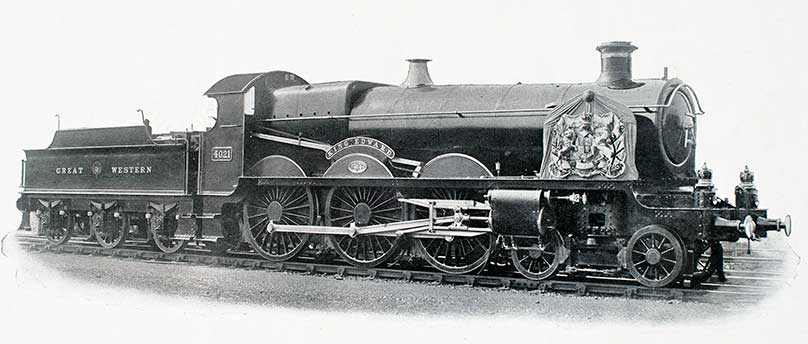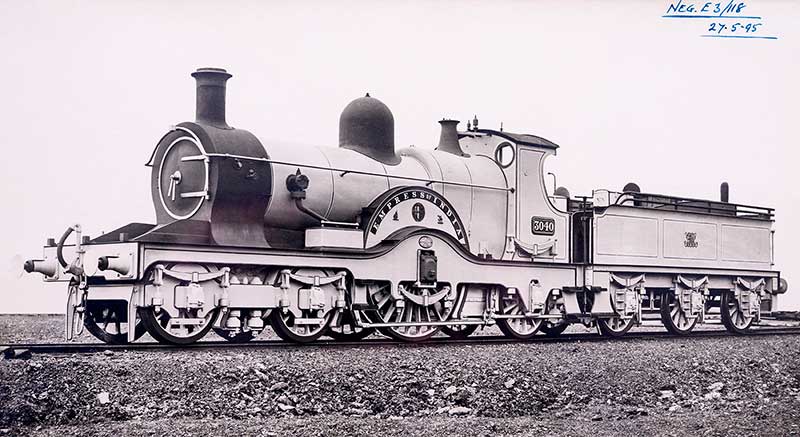Home » Other Articles » Going Loco Index » Going Loco - June 2022 - Going Loco - June 2022
Going Loco - June 2022
FRIDAY 24 JUNE
Control Freak?! - Part 1
I realised that one of the things that I have neglected for a while has been an instalment on our ‘how it works’ occasional series and as we have locomotives at Didcot Railway Centre where you can access the cab, I thought we could take a look at the controls in a Great Western steam engine cab and find out what they do. The controls on G.W.R. engines were pretty standardised by the 1920s. If you look in the cab of a Castle class express passenger engine or a Pannier tank shunting engine, there are a few differences, but not many. As the cab on display at the moment is that of No. 5900 Hinderton Hall, I'm going to take you on a virtual tour of this style cab. You will find layouts almost identical on No. 4079 Pendennis Castle and No. 5051 Earl Bathurst.
We are going to draw a line down the middle of the backhead or the rear section of the boiler. Whilst not 100% accurate, the vast majority of controls on the left are for the fireman and on the right are for the driver. We will look at the controls for the fireman this week. There are also controls on the tender too. These are all pretty much the province of the fireman as well. The large coal area and the water tank that surrounds it are self-explanatory as is the water gauge on the left as we look back.

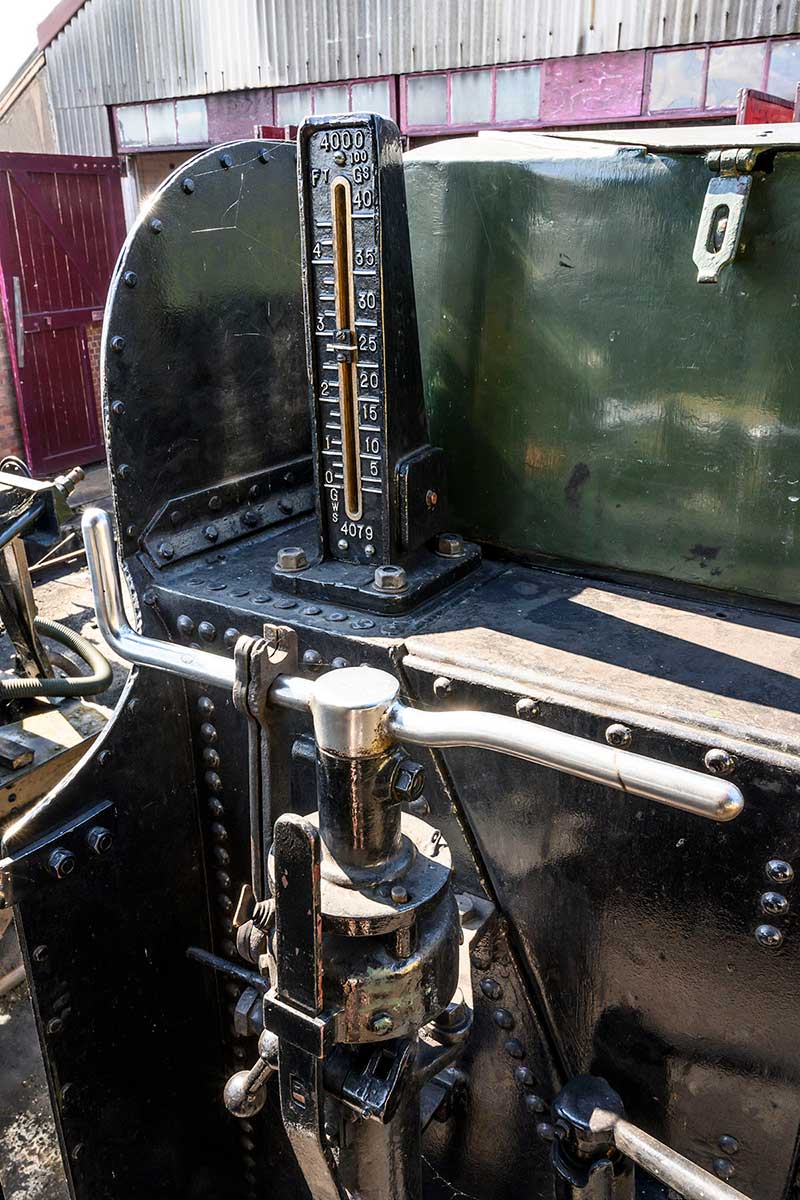
4079's handbrake and water scoop, with the gauge showing level of water in the tank behind it
There are two large handles on pedestals. The one on the right is the handbrake and there is a chain next to it. The chain is only put on the handle of the brake is on. It’s a good visual indicator and reminder. On the tender engines, only the tender has a handbrake. The loco wheels are only braked when the engine is in steam. The other large handle is the water scoop. This winds down a mechanism that was used for picking up water from troughs that were strategically placed at points on the main line. This meant the engine could pick up water on the move – about 3,000 gallons in a ‘scoop’! The two little handles are the water valves that turn the water on and allow it to flow in pipes towards the locomotive.
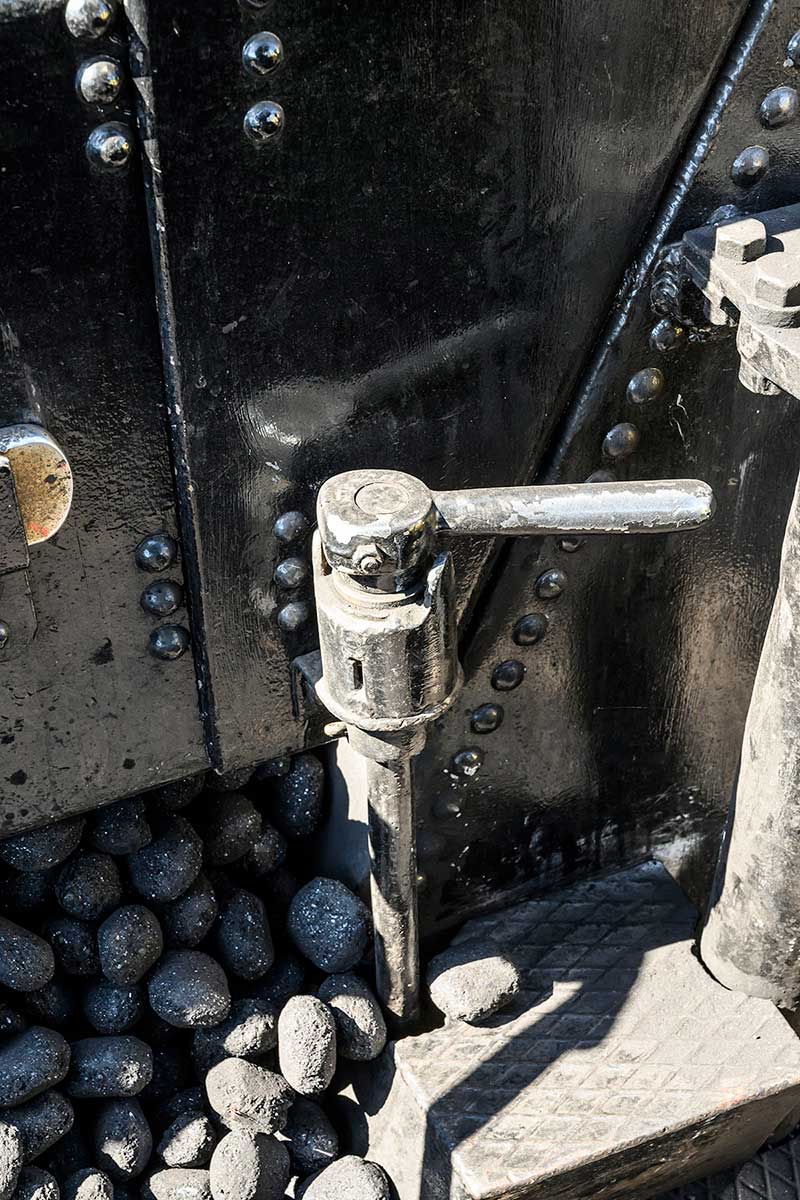
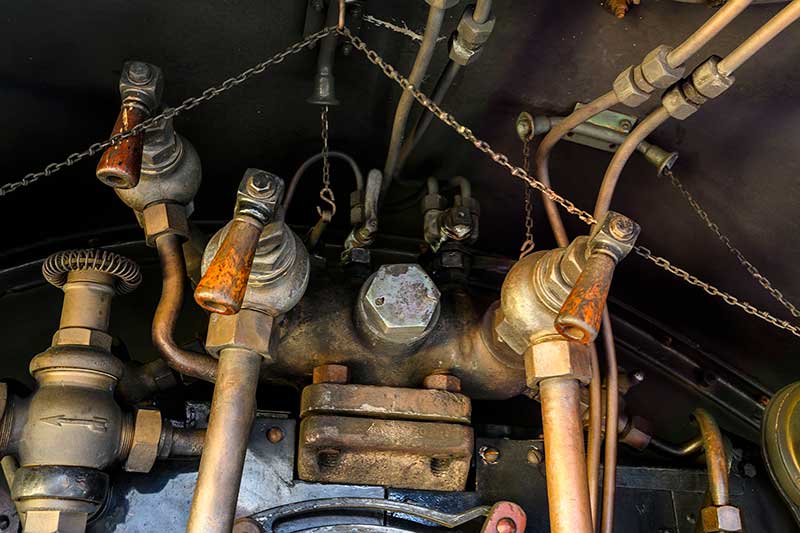
One of 4079's water valve handles and 4079's steam fountain, with the mason's valve on left
If we turn back to the locomotive, we can see that on top of the boiler, there is a large casting with all manner of taps and valves coming out of it. This is known as the fountain and it is where the steam for almost all of the auxiliary services on the engine. Most of the little valves are shut off cocks for the various systems. On the far left of the fountain, we start with what is known as the mason's valve. A tall brass casting with a wound wire handle. This is the pressure reducing valve for the steam heating for passenger coaches. The lagged pipe that leads down to the floor takes the low pressure steam to the train.
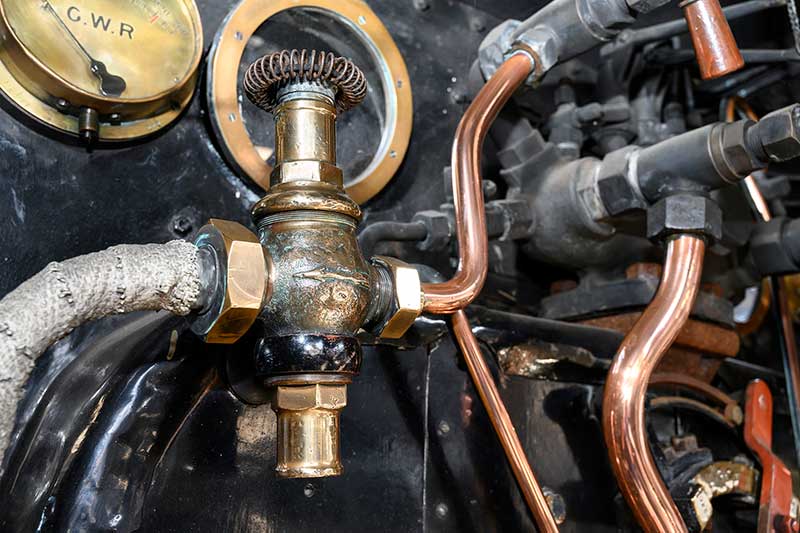
5322's mason's valve kept beautifully polished
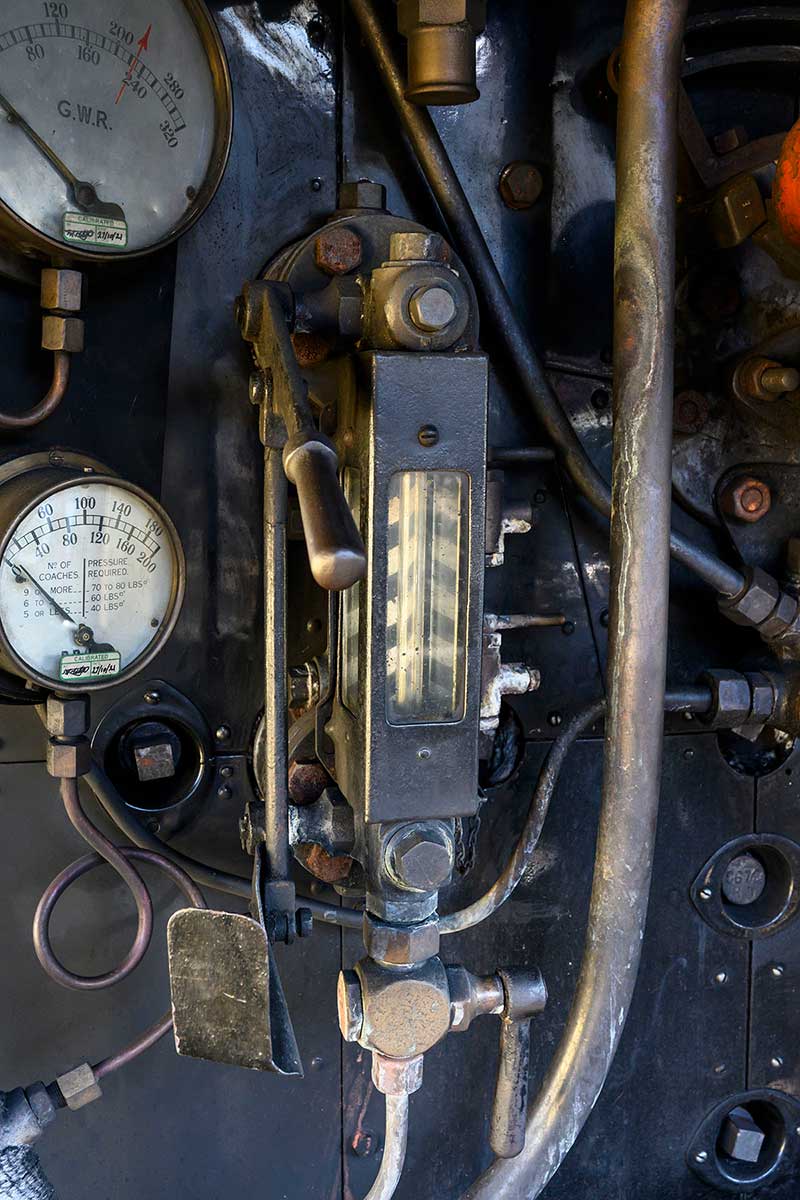
4079's gauge glass protector. The gauge on the left is for steam heat pressure to the train, controlled by the mason's valve.
On the front of the fountain are either two or three large spherical valves with large bore pipes leading down to the floor. These, in combination with the tender water valves, are the feeds to the injectors*. These get the water from the tender and past the boiler pressure into the boiler. How much water do you need to put in? Look no further than the gauge glass. This is the vertical glass tube in a glass box. The box – the gauge glass protector – has two functions. It provides protection for both the glass itself and the crew. It stops the glass tube from being broken by the crew accidentally and, if the gauge glass were to fail, it prevents the fast moving bits of glass from the resultant burst of steam from getting to the crew. There is a linkage on the side with a handle and this turns the gauge frame on and off. The little handle below it is the drain so you can empty it.

The pep pipe control on 5322.
All steam engines legally need two methods of reading the boiler water level. Most British locomotives have two gauge glasses, however, the Great Western Railway had to be different! The two large taps behind the gauge frame are called the test cocks. If you open them and water comes out, there is water there. If you open them and steam comes out, the water level is below that point. If it is below the level of the bottom one, you then put your injectors on as your boiler is very close to being too empty! Under the fireman's seat, is a small valve for the pep pipe. This is the hose that the fireman uses to hose down the cab to keep it clean and damp the coal to prevent dust**. The pep pipe operates when the fireman's side injector is turned on.
220624_4079-damper-handles.jpg)
The four damper handles on 4079
In the floor, there are 4 handles. These operate flaps on the ash pan and are known as the damper doors. By operating these, you can control the airflow to the underside of the fire. There are four on GWR 4-6-0s as the lower section of the ash pan is split in half by the rear driving wheel axle. So the handles, left to right, are front front, front rear, rear front, rear rear. Confused? You will be! The not yet mentioned elephant in the room (cab?) is the fire hole door.
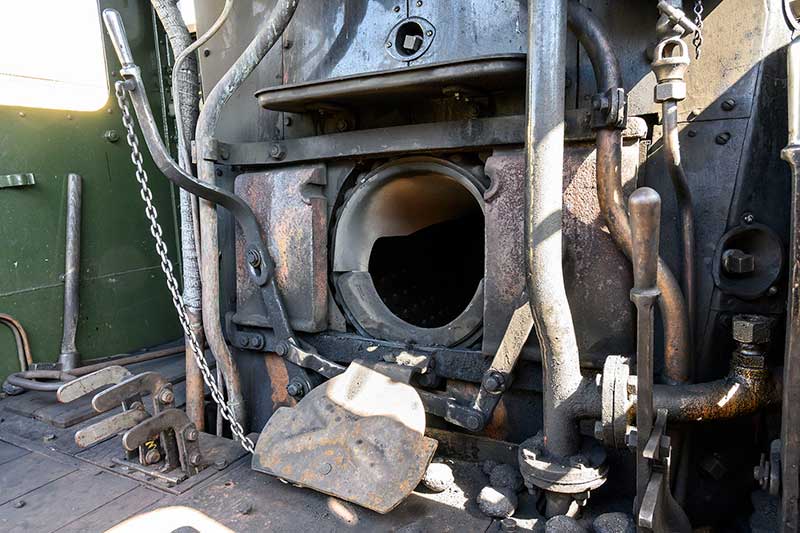
4079's firehole doors and flap. The damper handles can be seen on the left
There are two methods of closing it up. The first is the use of the large cast iron doors and the linkage and lever. This is quite heavy to operate so you will also notice that there is a steel flap on a hinge with a chain. This can be quickly and easily opened and closed by the firemen if they are working with the fire. Doors for longer periods shut, flap for brief. It basically helps the firemen conserve their energy.
And they do need their energy. The longest fireboxes on GWR locos are 11 to 12 feet in length. When firing, the fireman has to get the coal to exactly the right place. It's not just a case of fling it in! Holes in the fire draw cold air up the riveted joints and stays of the boiler. Being cold in one spot and hot in another causes the plates to twist and this can make leaks occur. Which annoys the boilersmiths and can be expensive… Oh, and if the engine is working hard, a big loco like a King or a Castle will consume fuel at the rate of up to 1 ton per hour. On that one shovel, in the right place, at the right time, on a footplate that will be bouncing around at anything up to (in steam days) 100mph+.
Whilst they are managing the water levels in the boiler and keeping the fire hole door fed, there is another job for the firemen. They need to use the windows. Strange as it may seem, the signals were on the left side of the cab and the driver was on the right. So, the fireman was an extra set of eyes for the driver too. They were a very skilled breed. They were also very busy… That's basically the fireman's controls. We need to take a look at the right side of the cab next week. Until then good people of the Internet…
*There's a previous blog for that!
**For some unknown reason, there is an idea going round by some that the coal is made wet to make it burn better. Do I have to point out why this is absolute nonsense?
FRIDAY 17 JUNE
The Great Western Royal Family - No Kings Allowed, Part 2
Welcome back to our Royal Round up part two – bringing to an end Going Loco’s recognition of the Platinum Jubilee of Her Majesty Queen Elizabeth II. We ended abruptly in the Dean period as frankly the thing was getting a bit long so with no [royal] ceremony we shall pick up the succession where we left off!
One of William Dean's more famous creations after the singles was his Duke class of outside frame* 4-4-0s. These engines have a somewhat complex history through some being rebuilt into the Earl or Dukedog class or the Bulldog class, various renumberings, renamings, name removals and so on. These express passenger engines were built in five batches between 1895 and 1899. They were long lived too. While the first was withdrawn as early as 1929, the last hung on until 1951.
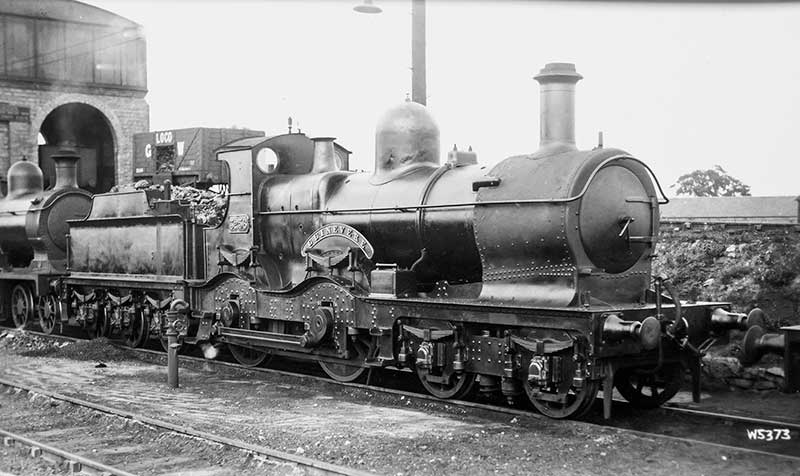
No. 3256 Guinevere (original number 3257).
As you might expect, the Dukes have a couple of royal connections. The first is that of a King and Queen of legend. Nos. 3256 Excalibur, 3257 Guinevere, 3258 King Arthur and 3273 Sir Lancelot. The class was originally known as the Pendennis Castle** class due to their association with the West Country (like King Arthur), but this was dropped early on.

No. 3257 King Arthur (original number 3258).
King Arthur’s court and his legends have no ‘easy association’ with actual historical figures but are important to the U.K. culturally so they warrant at least a mention.
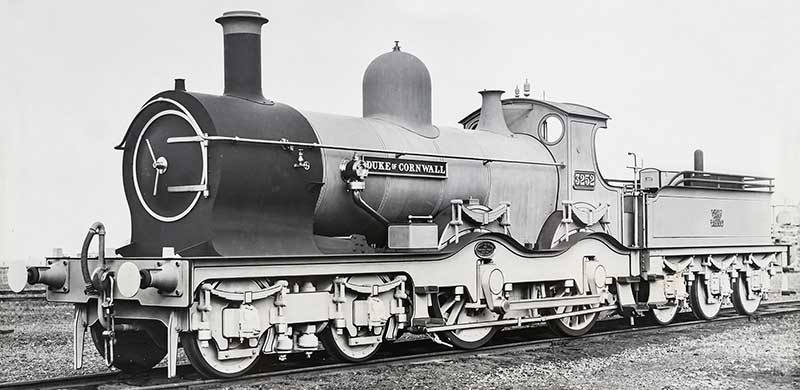
No. 3252 Duke of Cornwall.
The other is No. 3252 Duke of Cornwall. This peerage was created by royal charter in 1337 and is traditionally held by the oldest son of the reigning monarch. When the engine was constructed in 1895, the incumbent was the future King Edward VII and today of course is His Royal Highness Prince Charles.
The related Bulldog class of outside frame 4-4-0s had an actual King in their lineage. They too were passenger locomotives built between 1899 and 1910. Some of their ranks were new builds while others were rebuilds of the Duke class. Our engine is No. 3413 Edward VII. I probably don’t need to introduce you to Queen Victoria’s eldest again do I?!
There is also another link to the Arthurian Legend, No. 3364 Pendragon. In the stories, King Arthur's father is sometimes known as Uther Pendragon. The title is Welsh and roughly translated it means “Chief Warrior” but in reality means ‘Chief Leader’ or ‘Commander in Chief’.
With that, the reign of Dean came to an end in 1902 to be replaced with George Jackson Churchward. Here we get to look at the celestial Star class which, despite the name, actually had more royal family names than star names. It's just that the stars got there first… We will take a look at the original G.W.R. 4-cylinder express passenger 4-6-0s later but suffice to say that they are not just an outstanding design of themselves but they are the grandparents of the great lineage of Castles and Kings.
This is going to be a long list so…
There were ten Kings before there were the official and separate King class. There were no regnal numbers attached to the names so it is a bit of a free for all really but as there aren't any numbers, I'm going to assume that they are the first British monarch to use that name.
No. 4021 King Edward
No. 4021 King Edward, prepared to haul the King’s funeral train on 20 May 1910.
(17/18th June 1239 - 7 July 1307). Also known as ‘Edward Long shanks’ or ‘The Hammer of the Scots’. Did a lot of war type stuff both here and on Crusade. Definitely a man of his time…
No. 4022 King William
(~1028 - 09/09/1087) William the Conqueror, pretty darn famous in the U.K. 1066 and all that.
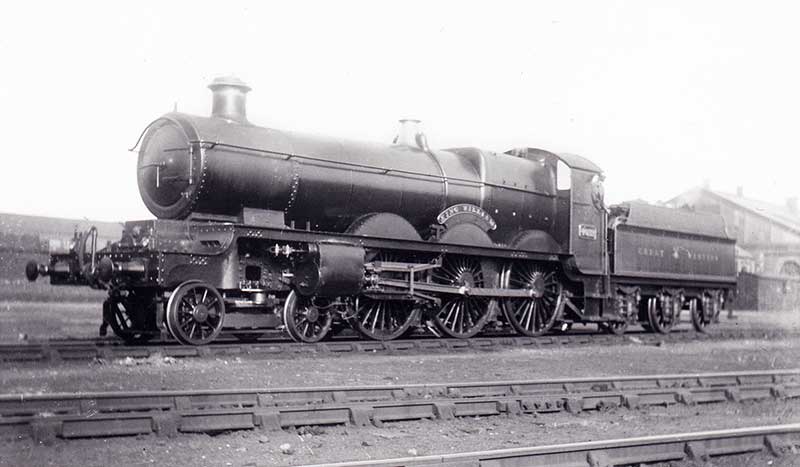
No. 4022 King William at Reading engine shed on 13 March 1926.
No. 4023 King George
(28/05/1660 –11/06/1727) First British monarch of the House of Hanover.
No. 4024 King James
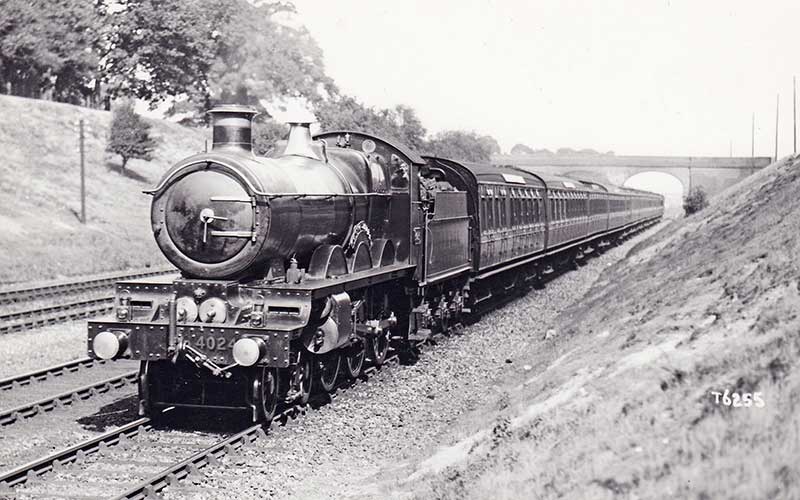
No. 4024 King James.
(19/06/1566 - 27/03/1625) Actually James VI of Scotland before becoming James I of the whole British Isles in 1603.
No. 4025 King Charles
(19/11/1600 - 27/03/1649) Ended up falling foul of a major separation in the country. That of his head from his body…
No. 4026 King Richard
(08/11/1157 - 06/04/1199) Another famous warrior King - ‘Richard the Lionheart’. He was so keen on the U.K. that he probably spent less than six months here once crowned. Lots of Crusading to do clearly…
No. 4027 King Henry
(~1068 - 01/12/1135) Fourth son of William the Conqueror. Also buried on a stop on the G.W.R. at the now ruined Reading Abbey.
No. 4028 King John

No. 4028 King John at Torquay c.1922.
(24/11/1166 - 19/10/1216) Not well liked. Still, his Barons that made him sign Magna Carta and that started off the British Constitution and is the cornerstone of the English system of liberty and justice that is one of our greatest gifts to the world.
No. 4029 King Stephen
(1092 or 1096 – 25/10/1154) His reign was marked by a charming little period known as ‘The Anarchy’. A civil war and not a Sex Pistols song…
No. 4030 King Harold
(? - 17/03/1040) Nope, not the battle of Hastings chap. This is the son of King Cnut, Harold Harefoot. Yes, you read that right. He was a bit nippy on his feet apparently…
The ‘Kings’ were all renamed to various different country’s Monarchs and as we fell out with those countries, the names were either changed or removed completely. Of better staying power were the ‘Queens’. I’ll gloss over the ones we’ve met already otherwise this will turn into a novel(!).
No. 4031 Queen Mary
Queen to King George V.
No. 4032 Queen Alexandra
Queen to Edward VII
No. 4033 Queen Victoria
HOW many G.W.R. engines were named after this woman?!
No. 4034 Queen Adelaide
(13/08/1792 - 02/12/1849) Adelaide of Saxe-Meiningen, Queen to King William VI and the lady that the city in Australia is named after.
No. 4035 Queen Charlotte
(19/05/1744 - 17/11/1818) Queen to George III - the ‘Mad King’ who is the longest serving male monarch of the U.K. Only Victoria and Elizabeth II have served us longer.
No 4036 Queen Elizabeth
(07/09/1533 - 24/03/1603) Gloriana, Good Queen Bess, The Faerie Queene, The Virgin Queen. Queen to Drake, Shakespeare, Marlowe and Raleigh. Last of the House of Tudor. Another of the almost legendary figures in British history.
No. 4037 Queen Philippa

No. 4037 Queen Philippa at Cardiff c.1922.
(24/06/1310 or 1315 - 15/08/1369) Philippa of Hainault. Wife and Queen to King Edward III and acted as his regent while he was away fighting the hundred year’s war. She was an astute politician and advised Edward III on many issues.
No. 4038 Queen Berengaria
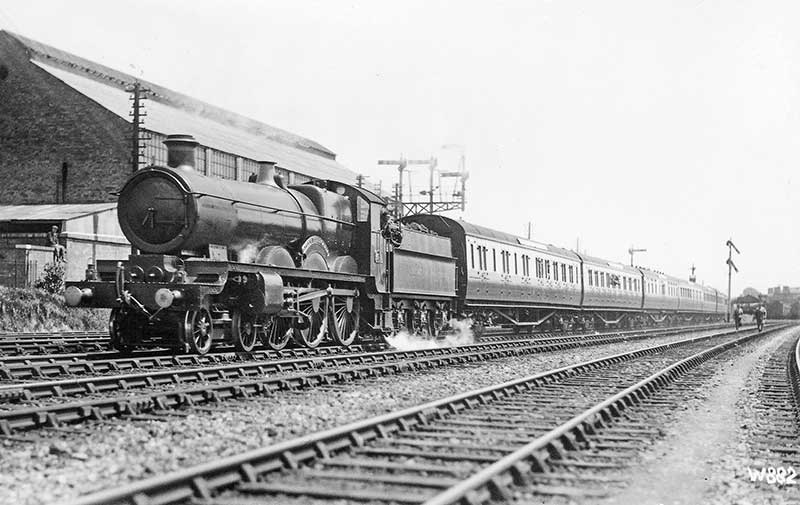
No. 4038 Queen Berengaria.
(c.1165 - 1170 -23/12/1230) Berengaria of Navarre. Queen to Edward I and sadly not much about her is known for sure…
No. 4039 Queen Matilda
(~07/02/1102 - 10/09/1167) Also known as Empress Maude. Was never actually Queen of England but was one of the claimants to the throne during the aforementioned Anarchy.
No. 4040 Queen Boadicea
(~30A.D. - 60 or 61 A.D.) Her actual name can be translated and pronounced all sorts of ways but she was a Queen of the British Iceni tribe who lead a massively destructive but ultimately doomed rebellion against the Imperial Roman forces then invading Britain. She has found a place in British culture as a folk hero so she is surrounded by much myth and legend.
And as of that wasn’t enough, we now get to the 20 Princes and Princesses. I said there were a lot…
No. 4041 Prince of Wales
As this engine was built in 1913, this makes the name that of the then Prince of Wales, the future King Edward VIII / Duke of Windsor.
No. 4042 Prince Albert
No, not Queen Victoria’s other half. At the time the loco was built, this was the name that King George VI was going by.
No. 4043 Prince Henry

No. 4043 Prince Henry.
(31/03/1900 - 10/06/1974) Henry William Frederick Albert. 4th child of King George V and Queen Mary. He was the Duke of Gloucester and also served as Governor - General of Australia.
No. 4044 Prince George
(20/12/1902 - 25/08/1942) George Edward Alexander Edmund. Another of King George V / Queen Mary’s children. He was killed in an air crash while on active duty with the R.A.F. making him the first royal to die as a result of military service in 450 years.
No. 4045 Prince John
(12/07/1905 - 18/01/1919) John Charles Francis. The youngest son of King George V and Queen Mary. He suffered from severe epilepsy and sadly passed away from a seizure at just 13 years of age.
No. 4046 Princess Mary
(25/04/1897 - 28/03/1965) Victoria Alexandra Alice Mary, Princess Royal and Countess of Harewood. The only daughter of King George V and Queen Mary. Known for her charitable work, particularly in the First World War which went towards the support of servicemen and their families.
No. 4047 Princess Louise
(20/02/1867 - 04/01/1931) Louise Victoria Alexandra Dagmar, Princess Royal and Duchess of Fife. Daughter of King Edward VII and sister to King George V. She was a shy character and led a largely private life.
No. 4048 Princess Victoria
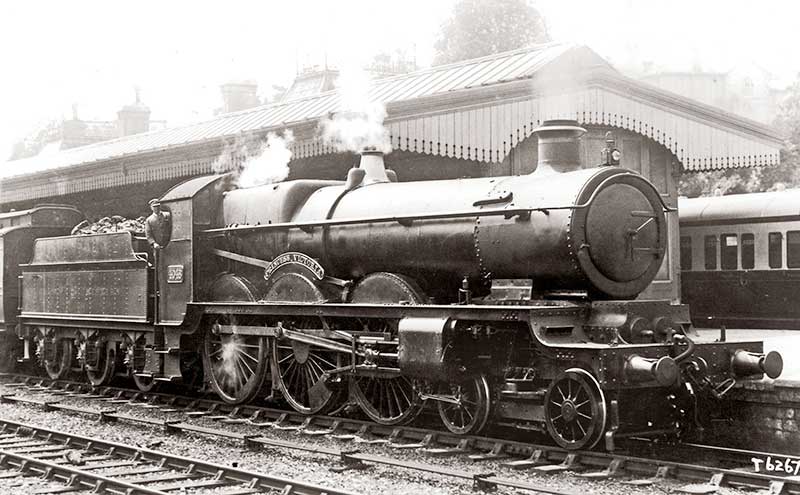
No. 4048 Princess Victoria.
(06/07/1868 - 03/12/1935) Victoria Alexandra Olga Mary. George V’s youngest sister.
No. 4049 Princess Maude
(26/11/1869 - 20/11/1938) Maude Charlotte Mary Victoria or Maude of Wales. The youngest daughter of King Edward VII. She married King Haakon VII of Norway, becoming his Queen when he was crowned in 1906.
No. 4050 Princess Alice
(25/02/1883 - 03/01/1981) Alice Mary Victoria Augusta Pauline or Princess Alice, Countess of Athlone. She was the last surviving granddaughter of Queen Victoria and was married to Lord Athlone, who served as Governor General of Canada.
No. 4051 Princess Helena
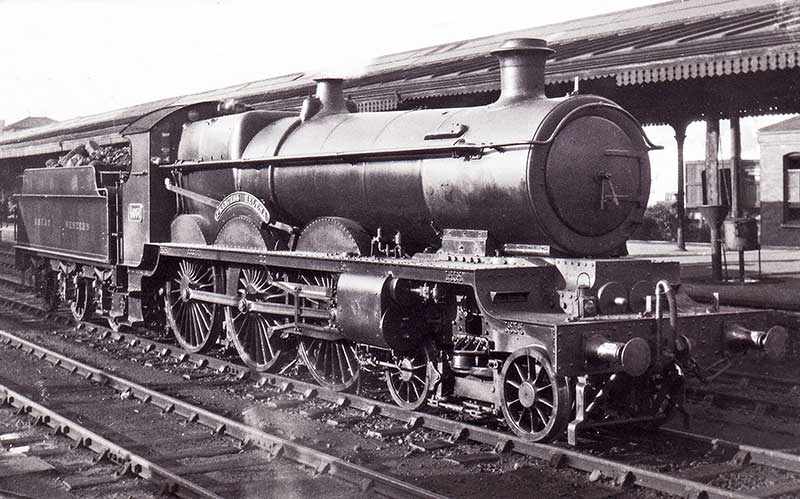
No. 4051 Princess Helena at Cardiff c. 1922.
(25/05/1846 - 09/06/1923) Helena Augusta Victoria. later Princess Christian of Schleswig-Holstein. 5th Child of Victoria and Albert. She was an active patron to charities and was also a founder member of the British Red Cross. She married Prince Frederick Christian Charles Augustus of Schleswig-Holstein.
No. 4052 Princess Beatrice
(14/04/1857 - 26/10/1944) Beatrice Mary Victoria Feodore, later Princess Henry of Battenberg. She was the youngest child of Victoria and Albert and the last of their children to die – a full 66 years after the first passed away.
No. 4053 Princess Alexandra
(17/05/1891 - 26/02/1959) Princess Alexandra, Duchess of Fife, née Lady Alexandra Victoria Alberta Edwina Louise Duff, later Princess Arthur of Connaught. She was the eldest surviving child of Edward VII. She became a nurse in WWI, stationed rather appropriately for us at St. Mary’s Hospital, Paddington!
No. 4054 Princess Charlotte
(24/07/1860 - 01/10/1919) Princess Viktoria Elisabeth Auguste Charlotte of Prussia was the eldest granddaughter of Victoria and Albert. She became the Duchess of Saxe-Meiningen when she married the duchy’s last ruler Bernhardt III.
No. 4055 Princess Sophia
(14/06/1870 - 13/01/1932) Sophie Dorothea Ulrike Alice, Sophia of Prussia was a granddaughter of Victoria and Albert and was the Queen to King Constantine I of Greece.
No. 4056 Princess Margaret
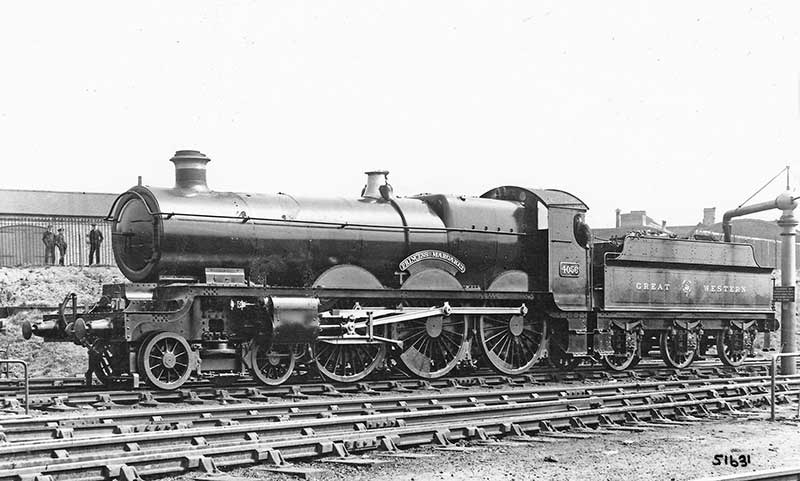
No. 4056 Princess Margaret.
(15/01/1882 - 01/05/1920) Princess Margaret Victoria Charlotte Augusta Norah of Connaught was another granddaughter of Victoria and Albert who became a Crown Princess of Sweden and first wife to King Gustaf VI Adolf. She died 30 years before her husband ascended to the throne, so she was never Queen.
No. 4057 Princess Elizabeth

No. 4057 Princess Elizabeth.
(01/11/1864 - 18/07/1918) Princess Elizabeth of Hesse and by Rhine, later Grand Duchess Elizabeth Feodorovna of Russia. She was a granddaughter of Victoria and Albert and is the great aunt of Queen Elizabeth II. She was murdered as part of the Russian revolution during WWI.
No. 4058 Princess Augusta
(19/07/1822 - 05/12/1916) Princess Augusta of Cambridge was a granddaughter of King George III and through marriage, became the Grand Duchess of Mecklenburg-Strelitz. She lived until the grand old age of 94 and was described by some as being ‘cantankerous’!
No. 4059 Princess Patricia
(17/03/1886 - 12/01/1974) Princess Victoria Patricia Helena Elizabeth of Connaught. She was a granddaughter of Victoria and Albert and married Admiral Sir Alexander Ramsey, a Royal Navy commander of some distinction from WWI.
No. 4060 Princess Eugenie
(24/10/1887 - 15/04/1969) Victoria Eugenie Julia Ena of Battenberg. She was the Queen of Spain, being married to King Alfonso XIII in 1906 and, yes to finish off, another granddaughter of Victoria and Albert!
That’s enough of that! I have trawled the history books for non-train facts aplenty. It is fascinating to see how the royal houses of Europe were intertwined and just what a huge impact that Queen Victoria and Albert had on our history. I find the context of the names that the G.W.R. chose fascinating. They were clearly keen to cement their association with the House of Saxe-Coburg and Gotha (from 1917 the House of Windsor). They were the first railway company to transport a reigning British monarch (Victoria) and their station in Windsor was a royal gateway to London and the rest of the country after all…
*Outside frame refers to the way that the structure that the wheels, boiler motion and cab is mounted on is arranged. If you look at the pictures of locomotives like the Dukes, you will see that the frames of the engine sit outside the wheels, the bearings are in this section and then any connecting rods are outside of that. It’s a traditional way of building steam engines that die out around the beginning of the 20th Century.
**Duke No. 3253 Pendennis Castle. This engine lost its name when our Pendennis Castle (No. 4079) was built in 1924. The letters on the original No. 4079 nameplates – now held in our museum – are those from the 1895 original. The G.W.R. never wasted anything!
FRIDAY 10 JUNE
The Pioneer's Progress - Part 6
Well, I WILL finish the Royal Round Up next time, but when Phil comes along with another great update on No 1466, you can't say no – am I right?! With the latest from 1466 Headquarters, here is the news from our roving reporter…
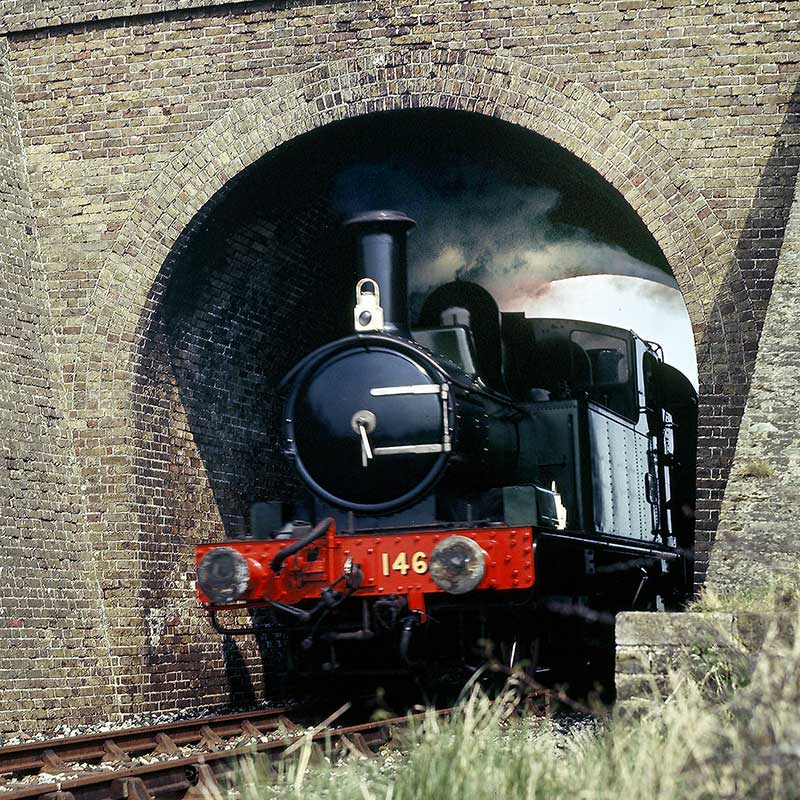
54 years ago, 1466 running on the Cholsey to Wallingford branch line in April 1968
Thanks Drew! It's been a very busy time recently and even with the previously mentioned copper conundrum, we are progressing forwards with the project very well. Orders have been placed with South Devon Railway Engineering (SDRE) to have a new copper tubeplate and door plate manufactured for the inner firebox, so we are currently somewhat in a bit of a waiting game… In the meantime, Ryan and his team at the West Somerset Railway have made great headway on the boiler of 1466 since my last update. So much so that, after copious amounts of time spent drilling and riveting, the boiler has finally taken back its true form once again and looks superb!
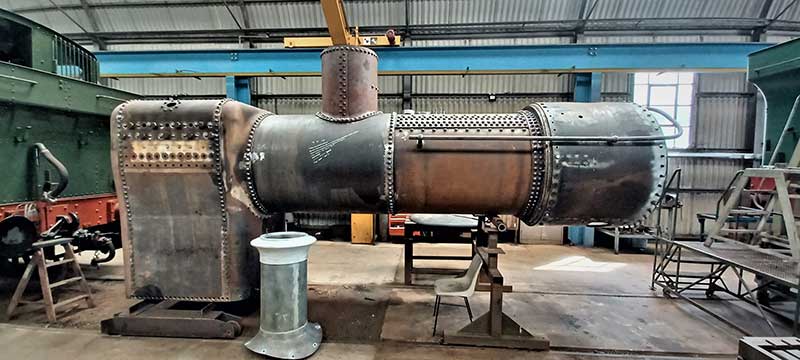
The boiler taken back to its natural form
With the riveting escapade complete and work on the boiler somewhat slowed until the new copper inner firebox components arrive, we have turned to fabricating and assembling the new smokebox and its associated parts. New smokebox? Well, due to the old smokebox of 1466 being very well worn (and quite holey!) it made sense to renew essentially everything. A new barrel has been fabricated along with a new sacrificial plate, inner and outer door pressing and front door-ring pressing which were made by SDRE. This will give a good lifespan and shouldn't need any remedial work to it, in the near to medium future.
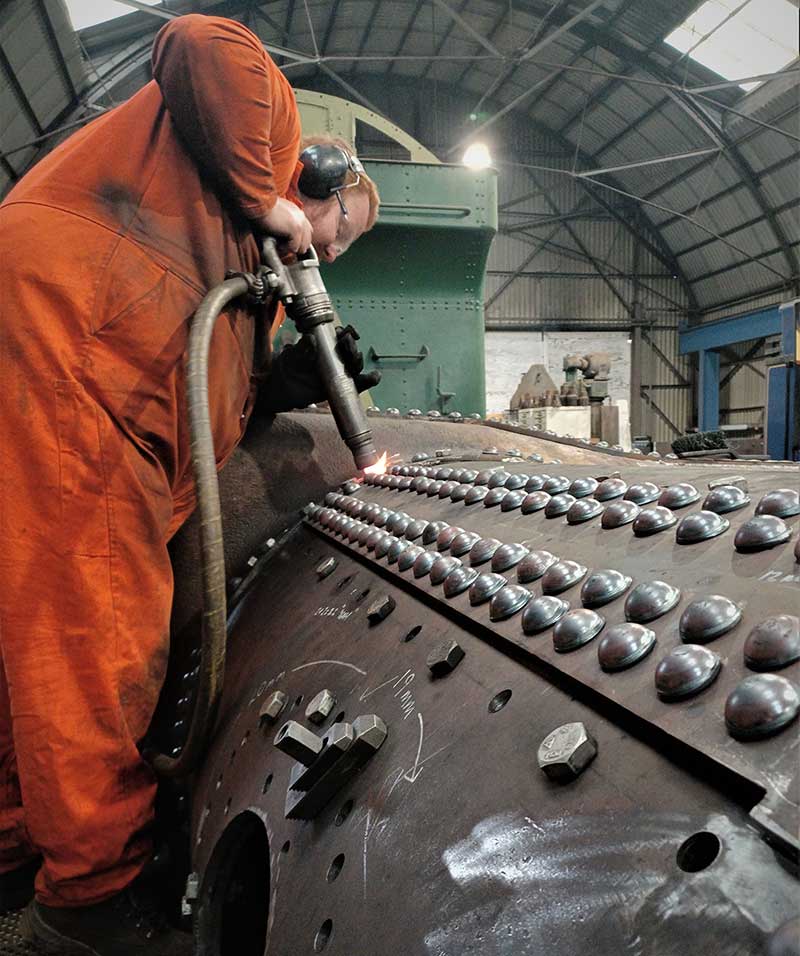
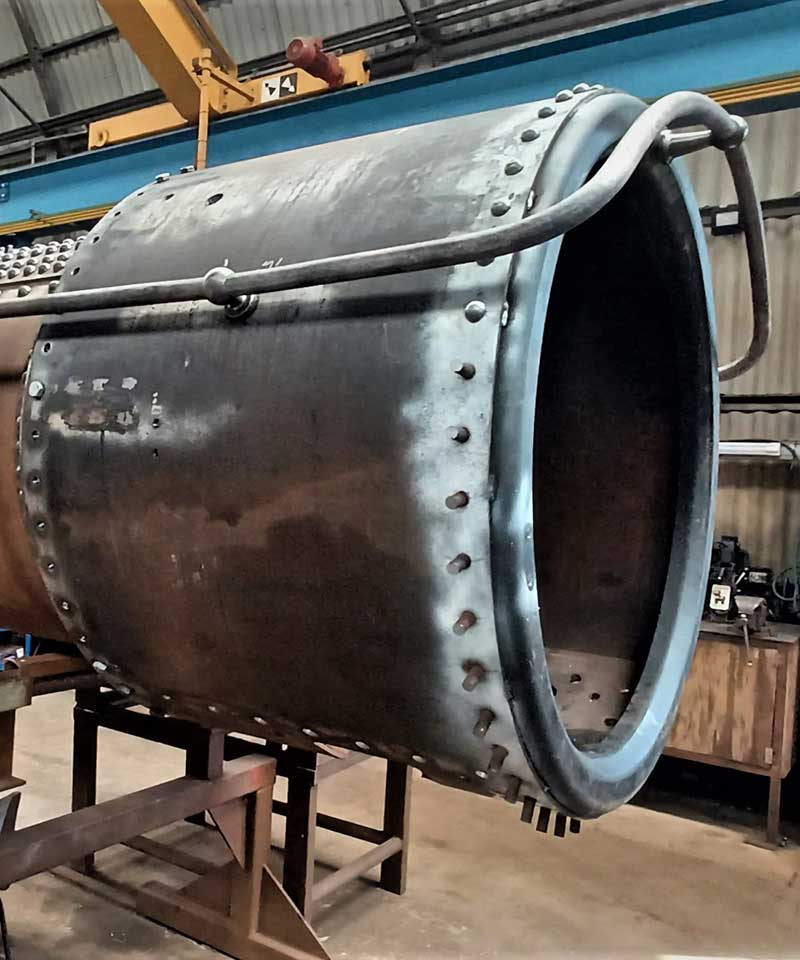
Ryan hitting down white hot rivets which secure the boiler barrel’s doubling plate and the new smokebox and its handrails taking shape. Both Photo's: Phil Morrell.
There has also been a smorgasbord of other odds and ends on the go; Ryan and his team have been working on machining the new blast-pipe and top casting. Time was taken to clean up the locomotive's chimney, by using a very fine sand blasting. Considering the chimney's age and use over the many years of service, it's in remarkably good condition. Due to a small area on the steel firebox crown being found to have significant wastage, a new piece of platework, 17”x17” in size, was sourced, introduced and welded in situ – it's quite a common occurrence, as the affected area is just below where the whistle sits. A result of water being expelled (and the UK's notorious rain for that matter…) and finding its way through the cladding and lagging, thus laying on the crown sheet, has caused the platework to deteriorate and waste away over the years. To end with, the final seal-welding by our contractor Ian Massey has started and will continue over the next few months.
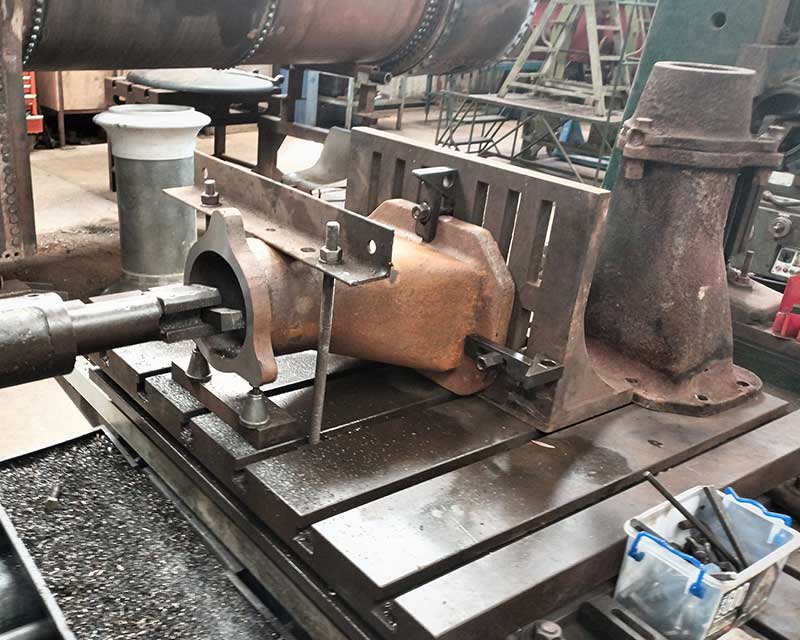
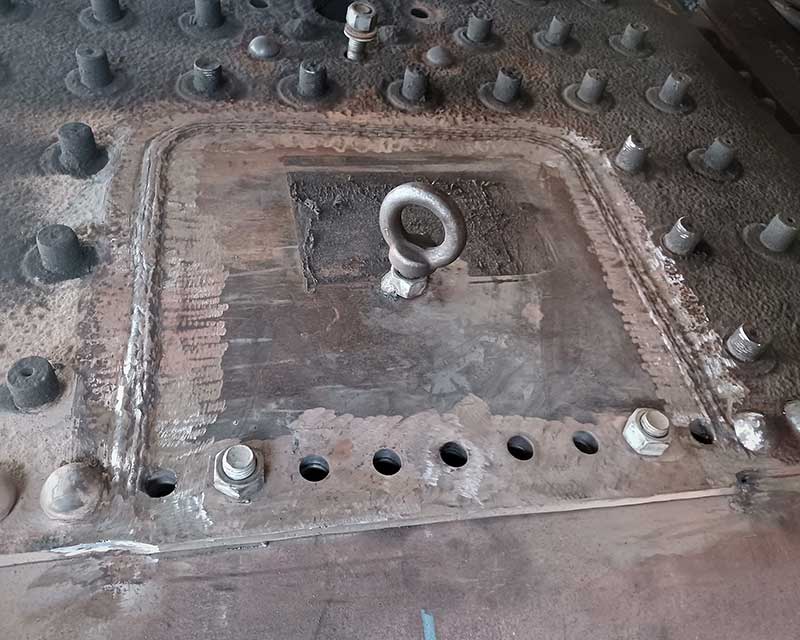
Machining the blast pipe (the old one can be seen behind) and a successful patch repair to the crown with a new 17 x 17 inch plate inserted. Both Photo's: Phil Morrell
So, what next? Well until the copper firebox components arrive (current eta of 6-8 weeks) and once the current work is complete, the highlights after that we'll be turning to are the overhaul of the following systems:
- The regulator pipe, steam collector and its associated parts.
- The steam dome lid will be re-faced and the steam dome itself will also be re-studded.
- We will also take this time to manufacture a new ashpan for the locomotive.
As well as all that, there will be fair amount of other work happening where various items and parts will be receiving attention, so do keep tuned! It's fair to say, work is progressing fairly rapidly on our little pioneer and there's still plenty more to come!
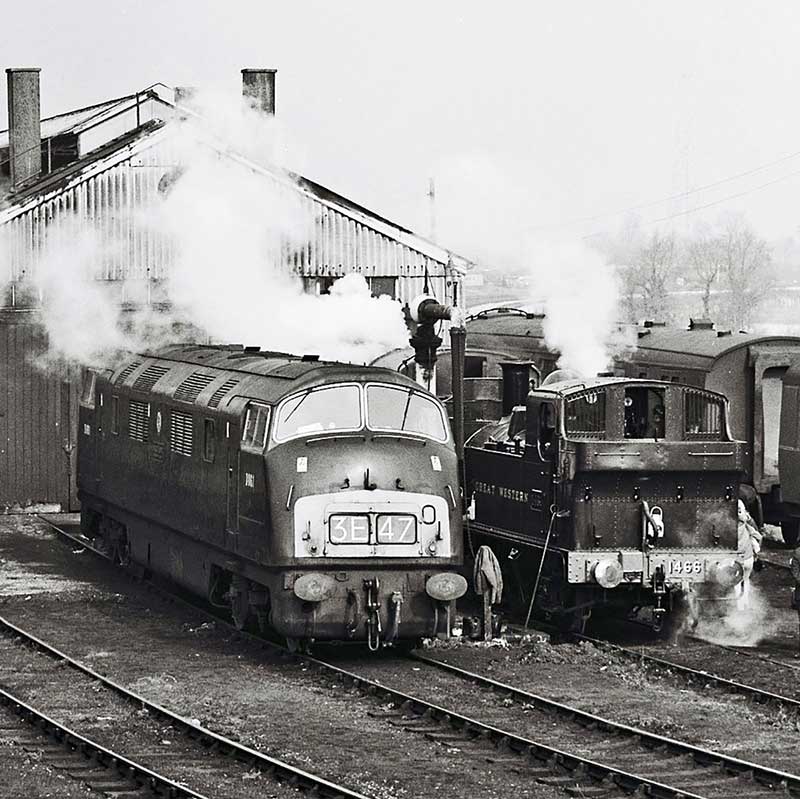
54 years ago, 1466 during a test steaming at Didcot engine shed in March 1968, alongside Warship class diesel-hydraulic No 861 Vigilant.
On a final note, I'd just like to thank everyone who has seen these blogs and the GW Echo updates and has been kind enough to donate to the project – it's truly and greatly appreciated. Any donations small, medium or large are always gratefully received. In a restoration such as this, every £1 counts and can make such a difference to enable us to finish her overhaul. If you would like to donate to this wonderful pioneering locomotive, please following the link and instructions below.
Until next time folks!
Cheers Phil! I can't wait to see this little beauty back where she belongs at Didcot, entertaining one and all. Having served as a Captain on the front lines of steam locomotive restoration, it gets to the point where you think to yourself ‘there CAN'T be anything else that I don't know about that needs doing can there?’ Quite often, there is, but with the kind of tenacity that Phil and his team have shown, I get the feeling that the time whereby the answer to that question is ‘no’ isn't that far off.
FRIDAY 3 JUNE
The Great Western Royal Family - No Kings Allowed, Part 1
In a furtherance of our Going Loco royal celebrations of Her Majesty Queen Elizabeth II’s Platinum Jubilee, Photo Frank came up with the great idea of tracking the royal family, with assistance from the photos in the Great Western Trust's collection of the Great Western locomotive fleet. With one twist. The 6000 or King class are not allowed. That would make it all too easy now wouldn't it?!
A long time ago, in Daniel Gooch's Swindon, not that far away ....
The earliest royal names I can find* are associated with two of the Prince Class 2-2-2 express passenger locomotives. Being that the class was built between 1846 and 1847, they were broad gauge machines. The two we are interested in today are Prince, built in 1846 and Queen built in 1847.
Given that this was the golden era of the Victorian age, it comes as no surprise that they are named after Queen Victoria (born 1819, reigned 1837-1901) and Prince Albert of Saxe-Coburg-Gotha, The Prince Consort (1819-1861). From about 1865 both the Prince class machines and the Firefly class were absorbed to become part of the Priam class. Which means a good look at our replica Fire Fly will serve to illustrate them perfectly! They were relatively successful for such early engines, being in service until 1870.
In the broad gauge Iron Duke class 4-2-2s we find Lord of the Isles, a title used by nobles in Scotland going back to the 12th century. It has been adopted by the British royal family and the current incumbent is His Royal Highness, Prince Charles (b1948). This photograph shows the locomotive decorated for the return of the Brigade of Guards from the Crimean War in 1856.
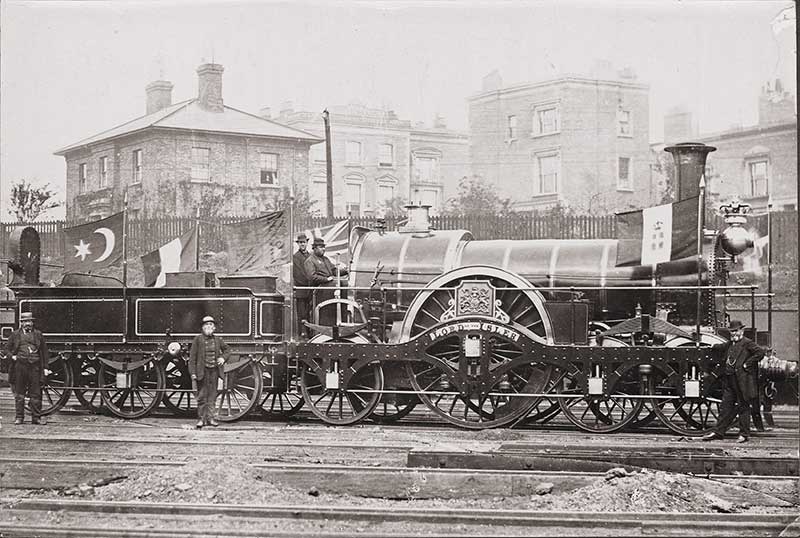
Given the fact that broad gauge engines built for the GWR were not bestowed with numbers, it is surprising to note that there was another engine named after Queen Victoria. Not confusing at all! In fact, the class were known as the Victoria class.
These were 2-4-0 express passenger engines and were a bit more modern, being built between 1856 and 1864. They were all named after heads of state of the era such as Abdul Medjid (the then ruler of Turkey) and Leopold (Leopold I of Belgium) or famous engineers such as Brunel, Trevithick and Watt.
Victoria herself has an interesting tale as her driver lost control on approach to Weymouth station on 26 August 1862. As a result, she smashed through the buffers and ended up sat in the street outside just short of the Somerset Hotel, with the commotion breaking up a game of cards! The incident gave rise to a local song with the refrain ‘Victoria in the gin-shop’.
The locomotive lasted until 1879 and the last Victoria class machine was scrapped in 1881.
Although we have to wait until nearly the end of his tenure at Swindon, Joseph Armstrong makes sure that the Royal Family were not forgotten at the scrapping of the Prince Class and gives us a whole host of royal names in the Queen Class! Well, I've clearly got my work cut out for me here, haven't I?

The prototype, No 55 Queen (Queen Victoria again) was built as an experimental machine in 1873. She was a 2-2-2 again, with driving wheels of 7’ diameter. The engine proved successful and a further 20 were built from 1875. Only half of them received names and the ones important to us are:
No 1118 Prince Christian
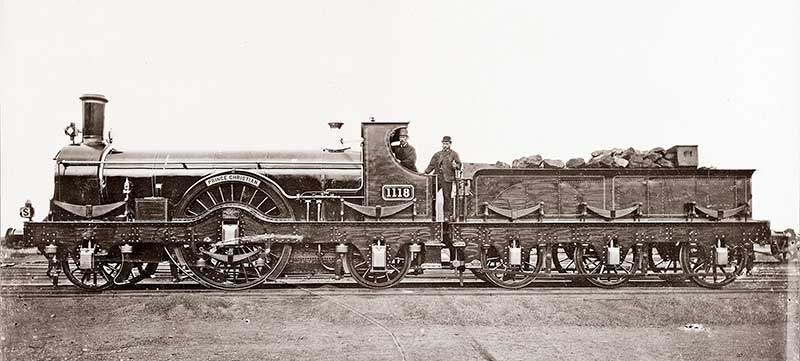
Prince Frederick Christian Charles Augustus of Schleswig-Holstein (1831-1917) was Danish born but a member of the German royal family. He became part of the British royal family due to his marriage to Princess Helena, fifth child of Victoria and Albert.
No 1119 Princess of Wales
Born as Alexandra of Denmark (1844-1925) The wife and Queen of future monarch, King Edward VII.
No 1128 Duke of York
The son of the Prince of Wales and Alexandra of Denmark, George Frederick Ernest Albert (1865-1936), known to history later as King George V.
No 1129 Princess May
The informal name of Mary of Teck (1867-1953) daughter of Francis, Duke of Teck (1837-1900) and Princess Mary Adelaide of Cambridge (1833-1897), Granddaughter of King George III (born 1738, reigned 1760-1820). She married the future King George V in 1893 to be later crowned as Queen Mary.
No 1132 Prince of Wales
The future King Edward VII (born 1841, reigned 1901-1910), made Prince of Wales in 1841 and crowned in 1901.
The Queen class were continually updated throughout their lives and received updated boilers, cabs and the like as technology improved. They were still working – albeit on secondary routes – until the last one was withdrawn in 1914. Some of them gained a total millage in excess of 1 million, which was quite the record for the time.
We now reach the tenure of William Dean at Swindon and the first two Royals here are oddballs. No 9 was originally built in 1881 as an experimental 4-2-4 tank engine but was an unmitigated disaster***. She was rebuilt to a 2-2-2 tender loco with strange outside Stephenson valve gear in 1884. She was rebuilt again to be very similar to the Queen class and then was named Victoria in honour of you know who.
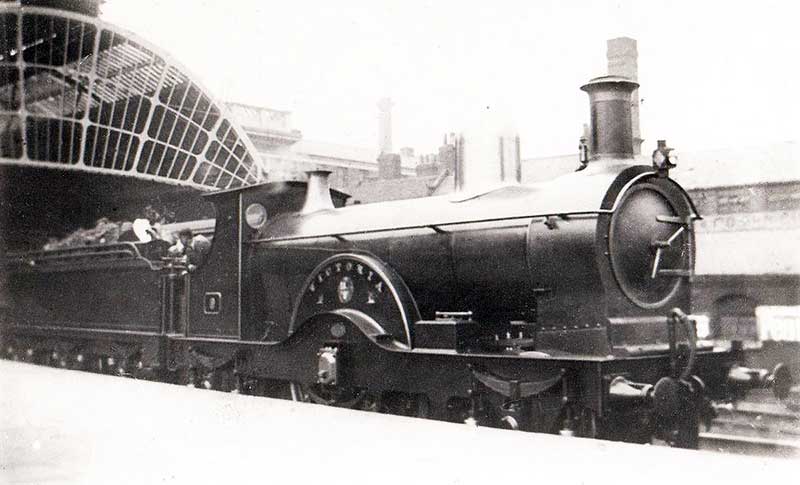
The next experimental engine was No 10 and this was built as a 2-2-2 from the outset and followed the same path as No 9. When finally rebuilt to an almost Queen class, she was named Royal Albert. Again, you know who this is ....
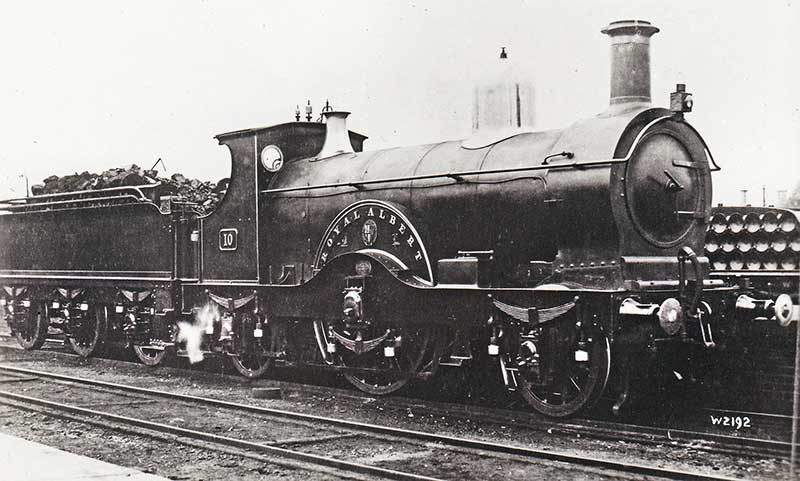
Apart from the famous Dean Goods 0-6-0 freight locos, William is best remembered for his Dean Single class of express passenger locomotives. There were 80 built in total but the first 30 were built as 2-2-2s of the 3001 class. These engines were found to be too heavy at the front end. A derailment caused by this happened in 1893. The solution, to give them a front bogie, resulted in one of the most beautiful locomotives of the Victorian era. The 3031 or Achilles class. They proved to be fleet of foot and were THE express passenger locomotive of its day. Their day was fairly short however, and by the early 20th century despite some rebuilding and a few other proposals, the last was withdrawn in 1914.
There are LOTS of royals in here, so here we go!
No 3004 Black Prince
The earliest Royal so far today – the Black Prince was Prince Edward (1330-1376), son of King Edward III (born 1312, reigned 1327-1377).
No 3040 Empress of India
Queen Victoria again! This title was bestowed on Queen Victoria in 1876. The reason was partly because her daughter Victoria, the Princess Royal (No 3073 below), had married in 1858 the future German Emperor and would in time become an Empress, outranking her mother who was merely a Queen. The title Empress of India put Queen Victoria on an equal footing with her daughter!
No 3046 Lord of the Isles

A second locomotive carrying that title. At the time No 3046 was built in January 1895, the broad gauge Lord of the Isles was still in existence, having been preserved at Swindon Works. The loco was offered to museums, but no willing takers so she was broken up in 1906. No 3046 did not last much longer, being withdrawn in October 1908.
No 3050 Royal Sovereign
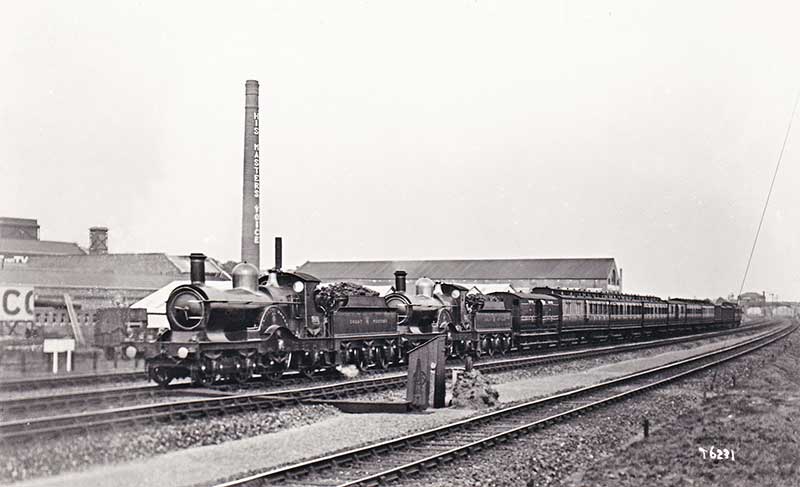
Queen Victoria again, again! Two in the same class .... This photograph shows Royal Sovereign double-heading with Princess Beatrice (see below) on a westbound train passing the His Master’s Voice factory at Hayes, about 1908.
No 3062 Albert Edward
The future King Edward VII.
No 3063 Duke of York
The future King George V.
No 3064 Duke of Edinburgh
The second son of Victoria and Albert, Alfred Ernest Albert (1844-1900), Duke of Saxe-Coburg-Gotha.
No 3065 Duke of Connaught
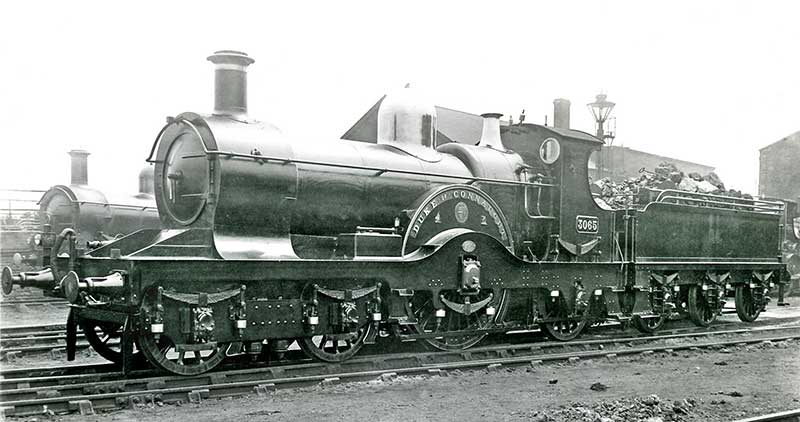
Prince Arthur, Duke of Connaught and Strathearn (1850-1942), seventh child of Victoria and Albert.
No 3066 Duchess of Albany
Princess Helen of Waldeck and Pyrmont, later Duchess of Albany (1861-1922), wife of Prince Leopold (1853-1884), eighth child of Victoria and Albert.
No 3067 Duchess of Teck
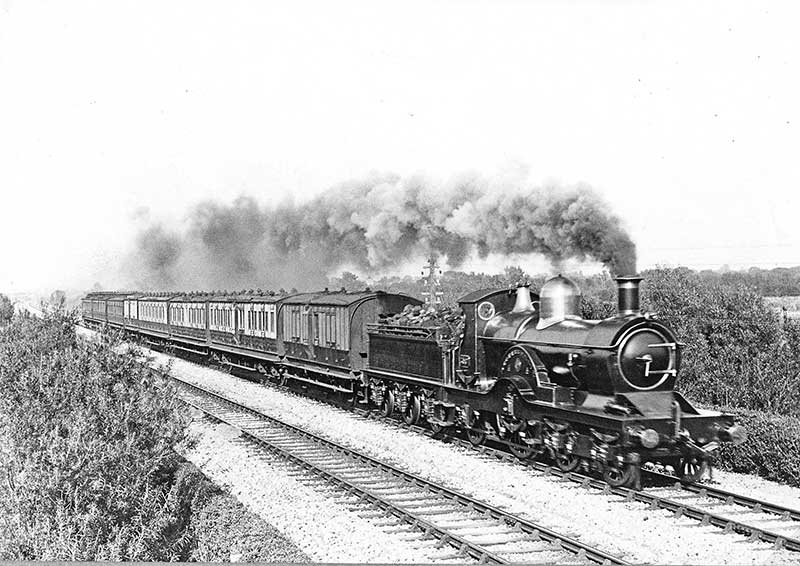
Mary of Teck, the future Queen Mary of King George V. This photograph shows No 3067 at the head of a local train, the first five vehicles of which appear to be London & North Western Railway stock followed by three GWR coaches.
No 3069 Earl of Chester
Another title of the future King Edward VII. Two for him too!
No 3073 Princess Royal
Victoria Adelaide Mary Louisa (1840-1901), eldest daughter of Victoria and Albert.
No 3074 Princess Helena
Helena Augusta Victoria (1846-1923), fifth child of Victoria and Albert.
No 3075 Princess Louise
Louise, Princess Royal and Duchess of Fife or Louise Victoria Alexandra Dagmar (1867-1931) was the third child and eldest daughter of Edward VII.
No 3076 Princess Beatrice
Beatrice Mary Victoria Feodore (1857-1944), later Princess Henry of Battenberg, was the youngest child of Victoria and Albert.
No 3077 Princess May
Queen Mary again.
This has been a great excuse for us to see some wonderful classes of locos that would never have been otherwise mentioned in Going Loco, so I make no apology for the heavy duty nerd stuff contained within! We still have a little way to go so we shall finish this one off next week. Happy holiday everyone!
*If you know better, please let us know!
**There are several blogs dealing with the broad gauge, find them in the Going Loco Archive.
***See Going Loco from Friday 22nd October 2021 Oh, The Horror!.
Didcot Railway Centre Newsletter
Stay up to date with events and what's going on at Didcot Railway Centre.
You may unsubscribe at any time. We do not share your data with 3rd parties.
